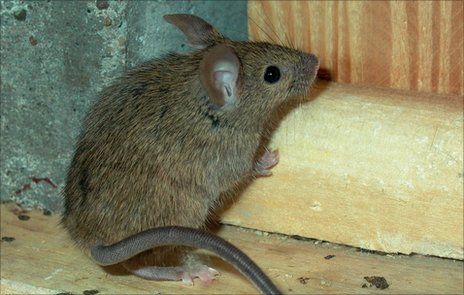German and Spanish mice have rapidly evolved the trait by breeding with an Algerian species from which they have been separate for over a million years.
The researchers say this type of gene transfer is highly unusual and normally found in plants and bacteria.
The Current Biology report says this process could yield mice resistant to almost any form of pest control.
Warfarin is a drug widely used in medicine as an anti-coagulant to prevent the build-up of harmful blood clots. It works through inhibiting a protein called VKORC1. This protein turns on our ability to produce vitamin K, which is essential for clotting.
Too much warfarin can cause fatal bleeding, and it was this quality that led to its introduction as a pesticide against rats and mice in the 1950s.
But the creatures have been slowly evolving traits to survive warfarin, and pockets of resistant rodents have been found in many different parts of the world.
Now scientists say that German and Spanish mice have found a rapid method of overcoming the threat by cross-breeding with Algerian mice that are, according to the researchers, an entirely different species.
Genetic exchange
Professor Michael Kohn from Rice University in Houston, Texas, led the team of researchers who carried out the work.
"Our study is so special because it involves hybridisation between two species of mouse that are 1.5-3 million years removed from each other.
"Most of the offspring... do not reproduce, they are sterile - but there is a small window, which remains open for genes to be moved from one species to the other, and that's through a few fertile females - so there is a chance to leak genes from one species to another."
I do foresee that many of these rat species will move across the globe - potentially have been moved; we just haven't detected them yet"Thanks to these few fertile females, the vast majority of mice in Spain and a growing number in Germany have acquired resistance over a very short period of time, although scientists aren't exactly sure when the first genetic exchanges took place.
Professor Michael Kohn
Rice University
And while they may not look any different from normal household mice, in their genetic code they now have the ability to survive the strongest chemicals in the pest control armoury.
"There are a lot of genetic barriers between these species of mice, to see them hybridise and transfer genetic material is quite spectacular, to be frank," said Professor Kohn.
The researchers say that increased human travel and population growth are responsible for bringing these mice species together and putting them under evolutionary stress by trying to poison them.
They are concerned that similar human pressures could afford rats both the necessity and the opportunity to breed across species, resulting in rodents that are almost impossible to control.
Evolutionary pressure
"In southeast Asia there are as many as 64 species of rats with many of these co-occurring in the same areas; in South Africa they have discovered a new species of rat that has rapidly moved from southeast Asia and which co-occurs with the other two species.
"I do foresee that many of these rat species will move across the globe - potentially have been moved; we just haven't detected them yet. So the potential for this interbreeding between these closely related rodent species and the exchange of resistance is given more often than it was in the past."
Professor Kohn believes that his research is an example of what scientists call horizontal gene transfer, a process normally seen in bacteria and plants but rarely in animals.
"There have been some accusations that we had oversimplified things by saying this is horizontal gene transfer - I believe that it is. But it is more special than that, because it has to overcome this hurdle of hybrid sterility in the first generation of offspring at the very least."
Other scientists aren't so sure. Dr Julie Dunning Hotopp is from the Institute for Genome Science at the University of Maryland, US. She says the house mouse story does not meet her definition.
"It's interesting work - but I wouldn't call it horizontal gene transfer, which I would say was gene exchange in the absence of sex.
"In many respects I don't think it's surprising, anytime you have a strong pressure like a pesticide, you will have the opportunity to have these changes.
"As humans we are applying more pressure, but we can observe the changes more easily as well thanks to improved genomic sequencing. We will find more examples like this because we can look for more.
But for now at least, the "super mice" have not made it as far as the UK, which Professor Rice thinks is a little odd as Britain was the first place to discover resistance in rats and mice in the 1960s.
"Our mice have not reached the UK as yet, which gives us some idea of how recent this is - but they could be on their way," he said.




It's generally far less miserable for the mice if one uses good old-fashioned mouse traps instead of adhesive traps or poison, anyway. Use peanut butter as the bait. They get a nice tasty treat, and next thing they know, they're in Mouse Heaven.
Unless these mice are faster than a locomotive and able to leap tall buildings in a single bound, I'm not really seeing the problem. Just stop using poison! Duh.